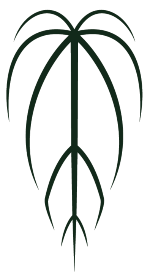What fertilizer do you use? This is one of our most frequently asked questions. When I started collecting, I struggled to find an anthurium-specific resource on fertilizer and nutrients. Overtime, I created a simple but effective combination of nutrients that keep my Anthuriums happy. Below are the nutrients I use and some helpful information to keep your Anthuriums happy too.
Ninety-five percent of our plants are grown in semi-hydro, so they sit in a reservoir of water. The plants are grown in a version of pon or treefern. (Future blog to come on substrates). We water with nutrients every time and we do not flush our plants. We do repot them on a fairly frequent basis. The same fertilizer mix is used for all our plants. We can eyeball the measurements now, but below is a general guideline:
We use a 3-gallon jug to mix the nutrients and we use about 1/2 to 3/4 strength of the recommended dose. Always err on the side of less fertilizer. If the concentration is too high, it can result in fertilizer burn that damages the plant.
-
Alchemist Stout MSA Monosilicic Acid 8-10 ml per 3 gallons: Alchemist Stout MSA Monosilicic Acid
-
Wait 20 minutes.
-
Maxsea Grow 16-16-16 1 teaspoon/5 ml per 3 gallons: Maxsea Grow
-
Humboldts Secret Calcium, Magnesium, and Iron 8-10 ml per 3 gallons: Humboldts Secret
-
Botanicare Hydroguard Bacillus Root Inoculant 5-8 ml per 3 gallons: Botanicare Hydroguard
We don't pH balance the solution and we haven’t had any issues. You can pH balance the solution to a slightly acidic pH of around 6. You can do this using a pH kit like General Hydroponics HGC722080 Control Balanced Nutrient Solution, pH Kit . We use reverse osmosis (RO) water, however, normal tap water will be fine.
The basic overview of nutrients and their purpose are listed below:
-
Nitrogen (N): Responsible for promoting healthy leaf growth and aiding in the production of proteins and enzymes.
-
Phosphorus (P): Plays a crucial role in root development and flower formation.
-
Potassium (K): Helps with overall plant health and disease resistance.
-
Calcium (Ca): Essential for cell wall structure and stability.
-
Magnesium (Mg): Involved in chlorophyll production.
-
Sulfur (S): Helps with protein synthesis and enzyme activity.
-
Iron (Fe): Essential for chlorophyll production and energy transfer within cells.
-
Manganese (Mn): Involved in enzyme activation and helps plants withstand stress conditions.
-
Zinc (Zn): Needed for the synthesis of growth hormones and promotes root development.
-
Copper (Cu): Aids in the formation of lignin, which strengthens cell walls.
-
Boron (B): Influences cell division and carbohydrate metabolism.
-
Molybdenum (Mo): Necessary for nitrogen fixation and helps convert nitrate into ammonia.
-
Chlorine (Cl): Involved in photosynthesis and osmotic regulation.
-
Nickel (Ni): Important for nitrogen metabolism and a component of urease.
-
Cobalt (Co): Essential for nitrogen fixation in legumes.
-
Sodium (Na): Beneficial for certain plants in osmotic regulation and photosynthesis.
-
Silica (Si): Supports plant growth by enhancing cell wall strength.
Disclaimer: These are the nutrients that work well in our conditions. Buz Plants is not responsible for any damage to your plants that may occur from using this combination of nutrients.

Share:
Buz Plants naming convention